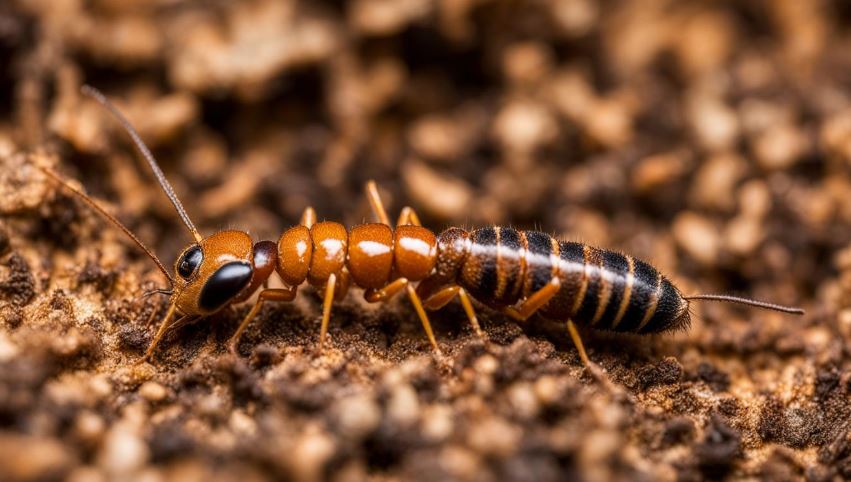Termites are insects that are known for their destructive nature and ability to infest and damage wooden structures. While many people are familiar with the damage caused by termites, there is often confusion about the color of termites and how it can be used to identify and understand these pests. In this article, we will explore the variety of termite colors, the significance of color in termite behavior and ecology, and how termites can be identified by their coloration.
In our experience of over 50 years of pest control and termite services at ACTION Termite & Pest control we can easily detect termites for you for your home or business. We have been doing this since 1969 and our specialty is termite treatment, inspections, and pest control.
Key Takeaways:
- Termites come in a range of colors, which can vary depending on the species and the role of the individual termite within the colony.
- Understanding termite coloration is crucial for identifying different termite species and castes within a colony.
- The color of termites plays a significant role in their behavior, ecology, and overall appearance.
- By recognizing termite colors and signs, homeowners can take proactive measures to protect their properties from termite infestations.
- Professional termite inspection is recommended for accurate identification and effective pest control.
Understanding Termite Coloration and Its Role in Identification
Termites display a fascinating array of colors, with variations depending on the species and the specific caste members within a colony. These distinctive colors play a crucial role in the identification of termites, enabling homeowners and pest control professionals to distinguish between different species and understand their behavior and ecology.
Termite Species and Their Distinctive Colors
Each termite species has its own characteristic colors, which can vary from light to dark tones. For example, the Eastern subterranean termite (Reticulitermes flavipes) is typically pale to creamy in color, while the Formosan termite (Coptotermes formosanus) has a darker brown or rusty appearance.
The color variations among termite species allow experts to identify and classify them accurately, aiding in targeted pest control efforts.
Color Variations Among Different Caste Members
Within a termite colony, there are distinct castes with specific roles, such as workers, soldiers, and swarmers. These different castes often exhibit variations in color, which further aid in their identification.
Workers, responsible for tasks such as nest construction and foraging, tend to have lighter or translucent colors. Soldiers, with their defensive and protective duties, often have a darker and more pigmented appearance. Swarmers, the reproductive individuals responsible for starting new colonies, generally have a darker coloration and are equipped with wings for dispersal.
Significance of Color in Termite Behavior and Ecology
The color of termites is not merely an aesthetic trait but has significant implications for their behavior and ecology. It can influence various aspects of termite life, including foraging patterns, communication methods, and reproductive activities.
For example, the darker coloration of soldier termites serves as a visual warning to potential predators, indicating their aggressive nature and ability to defend the colony. The specific coloration of swarmers can help them attract mates during the reproductive season.
Observing the color variations in termites provides valuable insights into their behaviors and allows professionals to develop effective strategies for termite control and prevention.
The Common Termite Colors Across The United States
The United States is home to several species of termites, each with its own characteristic colors. Understanding the common termite colors found across the United States is essential for homeowners and pest control professionals to identify and address termite infestations effectively.
Termites can be found in different regions of the United States, and their colors may vary based on location and species. While it is difficult to cover every specific termite color in this article, we will provide an overview of the most commonly encountered colors.
One common termite color seen across the United States is off-white or creamy white. This color is often associated with subterranean termites, which are among the most destructive termite species in the country.
Another prevalent termite color is light brown or yellowish-brown. This color is often found in drywood termites, which are known for infesting wooden structures and furniture.
Some termite species may have darker and more distinctive colors, such as black or dark brown. These colors are often seen in dampwood termites, which are commonly found in areas with high moisture content, like coastal regions.
It’s important to note that termite coloration can vary even within the same species, depending on factors such as age, caste, diet, and environmental conditions. Therefore, it is essential to consult with a professional entomologist or pest control expert for accurate identification of termite species based on color. One of our exterminators can help you decipher what type of termites you might have.
Identifying Termites by Color: Signs to Look Out For
The color of termites can provide important clues for identifying and detecting termite infestations. By understanding the unique colors associated with different termite castes and the presence of colored wings, homeowners can effectively assess the severity of the infestation and take appropriate measures for termite control.
Difference Between Swarmers, Workers, and Soldier Termites
Termites have distinct castes, each with its own coloration. Understanding the differences between swarmers, workers, and soldier termites can help in identifying the type of termites infesting your property and determining the appropriate treatment approach.
Swarmers, also known as alates, are reproductive termites that have wings and are responsible for starting new colonies. They typically have dark bodies with translucent or slightly pigmented wings. Workers, on the other hand, are usually lighter in color and lack wings. They are responsible for excavating tunnels, maintaining the colony, and feeding other members.
Soldier termites have larger heads and mandibles and are tasked with defending the colony. They may have a more pronounced color variation, with some species displaying yellowish or reddish-brown heads. Identifying the presence of soldier termites can indicate a mature and well-established termite colony.
Interpreting the Presence of Colored Wings in Termites
Colored wings in termites can provide crucial information about the stage of the termite life cycle and the potential threat of an infestation. Winged termites are known as “swarmers” and are reproductive members of the colony.
The wings of swarmers are typically equal in length and can vary in color depending on the species. Black or brown wings may indicate the presence of mature colonies, while clear or white wings may suggest the presence of newly formed colonies.
It is important to note that after a swarm, the wings are typically shed, so identifying discarded wings near windowsills, light fixtures, or other entry points can indicate a recent termite activity and the need for professional inspection and treatment.
Visual Indicators of Termite Infestations in Your Home
In addition to identifying termites by color, there are other visual indicators of termite infestations that homeowners should look out for:
- Wood damage: Termites feed on wood from the inside out, leaving behind damaged or hollow-sounding wood.
- Mud tubes: Termites build mud tunnels to travel from their underground nests to their food sources. These tubes can be found along foundation walls, crawl spaces, or other areas.
- Piles of wings: After a swarm, termite wings may accumulate in piles near windows or light sources.
- Frass: Termite droppings, known as frass, resemble tiny pellets and can often be found near termite tunnels or damaged wood.
If any of these visual indicators are present in your home, it is essential to seek professional termite inspection and treatment to prevent further damage and protect your property.
What Color Are Termites: A Closer Look at Termite Appearance
In this section, we will take a closer look at the physical appearance of termites, focusing on their coloration and other distinguishing features. Understanding the overall appearance of termites can help homeowners and pest control professionals in identifying and differentiating them from other wood-infesting insects.
Termites come in various colors, depending on the species. Some common termite colors include shades of white, cream, brown, and black. The coloration of termites can also vary within a single colony, with different individuals having different color patterns.
Along with color, termite physical characteristics play a significant role in their appearance. Termites have soft bodies that are typically segmented, resembling tiny grains of rice. They have straight antennae and their bodies are usually pale in color. The bodies of reproductive termites, known as swarmers, are darker in color compared to worker termites.
Additionally, termites have two pairs of wings, which can vary in color depending on the species. The wings of termite swarmers are usually longer and darker than those of worker termites. Winged termites are often mistaken for flying ants, but their physical characteristics and coloration can help differentiate them.
By understanding the termite appearance, including their coloration and other physical characteristics, homeowners and pest control professionals can better identify and address termite infestations. This knowledge allows for prompt and accurate termite treatment, safeguarding the structural integrity of buildings and preventing extensive damage caused by these wood-destroying pests.
Conclusion
In conclusion, professional termite inspection plays a vital role in accurately identifying termite species and infestations. Termites can cause significant damage to properties, and it is crucial to have an expert assessment to determine the extent of the problem and devise an appropriate treatment plan. By relying on the expertise of professionals, homeowners can ensure the effectiveness of termite control measures and prevent further damage.
Furthermore, being aware of termite colors and signs is essential for protecting your property from termites. Understanding the distinctive colors of different termite species and the signs of infestation can help homeowners take proactive measures. Early detection and timely intervention are key to minimizing the damage caused by termites and maintaining the structural integrity of your home.
By prioritizing professional termite inspection services and staying informed about termite colors and signs, homeowners can safeguard their investments and enjoy peace of mind. Don’t wait until it’s too late – take action now to protect your property from termite infestations.
FAQ
What colors are termites?
Termites come in a range of colors, which can vary depending on the species and the role of the individual termite within the colony. Common termite colors include pale white, cream, light brown, dark brown, and black.
How can termite colors be used to identify them?
Different termite species have distinctive colors that can be used to identify them. Additionally, the presence of colored wings in termites can indicate certain stages of the termite life cycle. Professional termite inspection can provide accurate identification based on color and other factors.
What are the common termite colors across the United States?
The United States is home to several species of termites, and each species has its own characteristic colors. Common termite colors found across the United States include white, cream, light brown, and black.
What signs can indicate termite infestations based on color?
Different termite castes, such as swarmers, workers, and soldiers, can be distinguished by their unique colors. The presence of swarmers with colored wings, such as black or brown, can also indicate the presence of a termite infestation. Visual indicators, such as mud tubes and wood damage, may accompany termite infestations.
How do termite colors contribute to their overall appearance?
Termites have different colors based on their species, castes, and stages of their life cycle. Their coloration, along with other physical characteristics like body shape, wings, and antennae, contribute to their overall appearance and can help in distinguishing them from other wood-infesting insects.
Why is professional termite inspection important for accurate identification?
Professional termite inspection is crucial for accurate identification of termite species and infestations. Trained professionals are skilled at identifying termites based on their color, physical characteristics, and behavior. Timely and accurate identification helps in implementing effective termite control measures.
How can awareness of termite colors and signs protect your property?
Being aware of termite colors and signs allows homeowners to take proactive measures to prevent termite infestations and protect their property from termite damage. Early detection and intervention can help save on costly repairs and maintain the structural integrity of homes.
If you need help with termites or a full service pest control company in the Phoenix, AZ metro area contact ACTION Termite & Pest Control for help.










